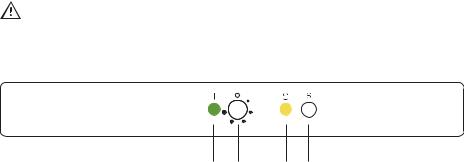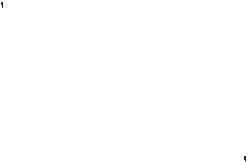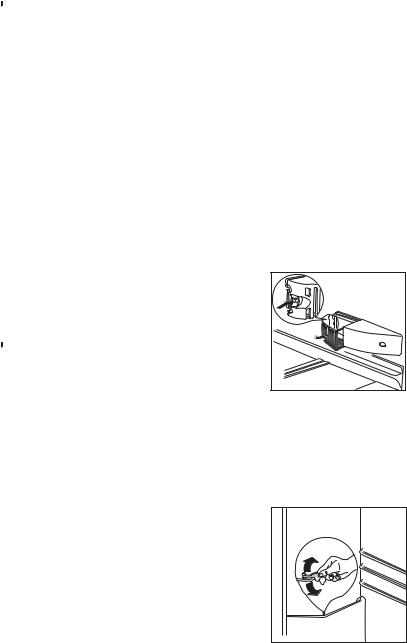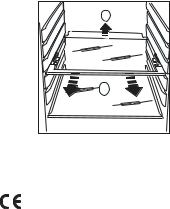Zanussi ZBB 6286 User Manual [ru]

FRIDGE-FREEZER
пйгйСагъзадейкйбагъзад
ZBB 6286
INSTRUCTION BOOKLET
азлнкмдсаь ий млнДзйЗдЦ а щдлигмДнДсаа икаЕйкД
2223 208-47

 WARNINGS
WARNINGS
It is most important that this instruction book should be retained with the appliance for future reference. Should the appliance be sold or transferred to another owner, or should you move house and leave the appliance, always ensure that the book is supplied with the appliance in order that the new owner can be acquainted with the functioning of the appliance and the relevant warnings.
If this appliance featuring magnetic door seals is to replace an older appliance having a spring lock (latch) on the door or lid, be sure to make that spring lock unusable before you discard the old appliance. This will prevent it from becoming a death-trap for a child.
These warnings are provided in the interest of safety.You must read them carefully before installing or using the appliance.
General Safety
•This appliance is not intended for use by persons (including children) with reduced physical, sensory or mental capabilities, or lack of experience and knowledge, unless they have been given supervision or instruction concerning use of the appliance by a person responsible for their safety.
Children should be supervised to ensure that they do not play with the appliance.
•It is dangerous to alter the specifications or modify this product in any way.
•Before any cleaning or maintenance work is carried out, be sure to switch off and unplug the appliance.
•This appliance is heavy. Care should be taken when moving it
•Ice lollies can cause frost burns if consumed straight from the appliance.
•Take utmost care when handling your appliance so as not to cause any damages to the cooling unit with consequent possible fluid leakages.
•The appliance must not be located close to radiators or gas cookers.
•Avoid prolonged exposure of the appliance to direct sunlight.
•There must be adequate ventilation round the back of the appliance and any damage to the refrigerant circuit must be avoided.
•For freezers only (except built-in models): an ideal location is the cellar or basement.
•Do not use other electrical appliances (such as ice cream makers) inside of refrigerating appliances.
Service/Repair
•Any electrical work required to install this appliance should be carried out by a qualified electrician or competent person
•This product should be serviced by an authorized Service Centre, and only genuine spare parts should be used.
•Under no circumstances should you attempt to
repair the appliance yourself. Repairs carried out by inexperienced persons may cause injury or more serious malfunctioning. Refer to your local Service Centre, and always insist on genuine spare parts.
•This appliance contains hydrocarbons in its cooling unit; maintenance and recharging must therefore only be carried out by authorized technicians.
Use
•The domestic refrigerators and freezers are designed to be used specifically for the storage of edible foodstuffs only.
•Best performance is obtained with ambient temperature between +18°C and +43°C (class T); +18°C and +38°C (class ST); +16°C and +32°C (class N); +10°C and +32°C (class SN). The class of your appliance is shown on its rating plate.
Warning: when the ambient temperature is not included within the range indicated for the class of this appliance, the following instructions must be observed: when the ambient temperature drops below the minimum level, the storage temperature in the freezer compartment cannot be guaranteed; therefore it is advisable to use the food stored as soon as possible.
•Frozen food must not be re-frozen once it has been thawed out.
•Manufacturers’ storage recommendations should be strictly adhered to. Refer to relevant instructions.
•The inner lining of the appliance consists of channels through which the refrigerant passes. If these should be punctured this would damage the appliance beyond repair and cause food loss. DO NOT USE SHARP INSTRUMENTS to scrape off frost or ice. Frost may be removed by using a plastic scraper. Under no circumstances should solid ice be forced off the liner. Solid ice should be allowed to thaw when defrosting the appliance.
•Do not place carbonated or fizzy drinks in the freezer as it creates pressure on the container, which may cause it to explode, resulting in
2

damage to the appliance. Do not use a mechanical device or any artificial means to speed up the thawing process other than those recommended by the manufacturer. Never use metal objects for cleaning your appliance as it may get damaged.
Installation
•During normal operation, the condenser and compressor at the back of the appliance heat up considerably. For safety reasons, minimum ventilation must be as shown in the instructions.
Attention: keep ventilation openings clear of obstruction.
•Care must be taken to ensure that the appliance does not stand on the electrical supply cable.
Important: if the supply cord is damaged, it must be replaced by a special cord or assembly available from the manufacturer or its service agent.
•If the appliance is transported horizontally, it is possible that the oil contained in the compressor flows in the refrigerant circuit. It is advisable to wait at least two hours before connecting the appliance to allow the oil to flow back in the compressor.
•There are working parts in this product which heat up. Always ensure that there is adequate ventilation as a failure to do this will result in component failure and possible food loss. See installation instructions.
•Parts which heat up should not be exposed. Wherever possible the back of the product should be against a wall.
 Environment Protection
Environment Protection
This appliance does not contain gasses which could damage the ozone layer, in either its refrigerant circuit or insulation materials. The appliance shall not be discarded together with the urban refuse and rubbish. Avoid damaging the cooling unit, especially at the rear near the heat exchanger. Information on your local disposal sites may be obtained from municipal authorities. The materials used on this appliance marked by the symbol  are recyclable.
are recyclable.
The symbol  on the product or on its packaging indicates that this product may not be treated as household waste. Instead it shall be handed over to the applicable collection point for the recycling of electrical and electronic equipment. By ensuring this product is disposed of correctly, you will help prevent potential negative consequences for the environment and human health, which could otherwise be caused by inappropriate waste handling of this product. For more detailed information about recycling of this product, please contact your local city office, your household waste disposal service or the shop where you purchased the product.
on the product or on its packaging indicates that this product may not be treated as household waste. Instead it shall be handed over to the applicable collection point for the recycling of electrical and electronic equipment. By ensuring this product is disposed of correctly, you will help prevent potential negative consequences for the environment and human health, which could otherwise be caused by inappropriate waste handling of this product. For more detailed information about recycling of this product, please contact your local city office, your household waste disposal service or the shop where you purchased the product.
CONTENTS |
|
Warnings . . . . . . . . . . . . . . . . . . . . . . . . . . . . . . . . . . . . . . . . . . . . . . . . . . . . . . . . . . . . . . . . . . . . . . . . . . . |
2 |
Use - Cleaning the interior - Operation - Temperature regulation - Quick-freezing - Freezing fresh food - . . . |
4 |
Use - Storage of frozen food - Ice-cube production - Operation - Temperatur regulation - . . . . . . . . . . . . . . . . |
|
Fresh food refrigeration - Thawing . . . . . . . . . . . . . . . . . . . . . . . . . . . . . . . . . . . . . . . . . . . . . . . . . . . . . . . . . . . |
5 |
Use - Movable shelves - Positioning the door shelves . . . . . . . . . . . . . . . . . . . . . . . . . . . . . . . . . . . . . . . . . . . . |
6 |
Hints - Hints for refrigeration - Hints for freezing - Hints for storage of frozen food . . . . . . . . . . . . . . . . . . . . . . |
7 |
Maintenance - Periods of no operation - Periodic cleaning - Illumination lamp - Defrosting . . . . . . . . . . . . |
8 |
Customer service and spare parts - Technical information . . . . . . . . . . . . . . . . . . . . . . . . . . . . . . . . . . . |
9 |
Installation - Location - Shelf-holders - Electrical connection . . . . . . . . . . . . . . . . . . . . . . . . . . . . . . . . . . . 10
Installation - Door reversibility - Building-in instructions . . . . . . . . . . . . . . . . . . . . . . . . . . . . . . . . . . . . . . . . 11
3

USE
Cleaning the interior
Before using the appliance for the first time, wash the interior and all internal accessories with lukewarm water and some neutral soap so as to remove the typical smell of a brand-new product, then dry thoroughly.
Do not use detergents or abrasive powders, as these will damage the finish.
Control panel
A B C D
A.Pilot light
B.Thermostat knob
C.Super control light
D.Normal/Super push button
Operation
Use of the freezer
Insert the plug into the wall socket. The pilot light (A) will light up, indicating that the appliance is powered. Turn the thermostat knob (B), clockwise, beyond the «O» (STOP) position.
Temperature regulation
The temperature is automatically regulated and can be increased to achieve a higher temperature (warmer) by rotating the thermostat knob toward lower ● settings or reduced (colder) rotating the knob towards higher ● settings.
However, the exact setting should be chosen keeping in mind that the temperature inside the refrigerator depends on:
•room temperature;
•how often the door is opened;
•the quantity of food stored;
•location of appliance.
Quick-freezing
For quick-freezing, push the Normal/Super button
(D). The super control light (C) will then light up. The Quick-freezing function accelerates the freezing of fresh food and, at the same time, protects foodstuffs already stored from undesirable warming.
If this function is not ended manually, the appliance switches off the Quick-freezing function after 52 hours. The yellow light goes out.
This function can be ended manually at any time by pressing the Normal/Super button again. The yellow light goes out.
Freezing fresh food
The 4-star compartment is suitable for long term storage of commercially frozen food and for freezing fresh food.
To freeze fresh foods it is not necessary to move the thermostat knob from the normal setting. Push the Normal/Super push button at least 3 hours before loading food.
Place the food to be frozen in the lower of the freezer compartment as this is the coldest part.
4

Storage of frozen food
When first starting-up or after a period out of use, before putting the products in the compartment let the appliance run for at least two hours on the coldest setting, then turn the thermostat knob to the normal operating position.
 Important
Important
In the event of accidental defrosting, for example due to a power failure, if the power has been off for longer that the value shown in the technical characteristics chart under “rising time”, the defrosted food must be consumed quickly or cooked immediately and then refrozen (after cooling).
Ice-cube production
This appliance is equipped with one or more trays for the production of ice-cubes. Fill these trays with water, then put them in the freezer compartment.
Do not use metallic instruments to remove the trays from the freezer.
Thawing
Deep-frozen or frozen food, prior to being used, can be thawed in the refrigerator compartment or at room temperature, depending on the time available for this operation.
Small pieces may even be cooked still frozen, directly from the freezer: in this case, cooking will take longer.
Use of the refrigerator
The thermostat is valid for both freezer and refrigerator compartments.
Temperature regulation
The temperature is automatically regulated and can be increased to achieve a higher temperature (warmer) by rotating the thermostat knob toward lower ● settings or reduced (colder) rotating the knob towards higher ● settings.
However, the exact setting should be chosen keeping in mind that the temperature inside the refrigerator depends on:
•room temperature;
•how often the door is opened;
•the quantity of food stored;
•location of appliance.
 Important
Important
If the ambient temperature is high or the appliance is fully loaded, and the appliance is set to the lowest temperatures, it may run continuously causing frost to form on the rear wall. In this case the dial must be set to a higher temperature to allow automatic defrosting and therefore reduced energy consumption.
Fresh food refrigeration
To obtain the best performance:
•do not store warm food or evaporating liquids in the refrigerator;
•do cover or wrap the food, particularly if it has a strong flavour.
•Position food so that air can circulate freely round it.
5

Movable shelves
The walls of the refrigerator are equipped with a series of runners so that the shelves can be positioned as desired.
For better use of space, the front half-shelves can lie over the rear ones.
Positioning the door shelves
To permit storage of food packages of various sizes, the door shelves can be placed at different heights.
To make these adjustments proceed as follows: Gradually pull the shelf in the direction of the arrows until it comes free, then reposition as required.
D338 |
6
 HINTS
HINTS
Hints for refrigeration
Useful hints:
Meat (all types): wrap in polythene bags and place on the glass shelf above the vegetable drawer.
For safety, store in this way only one or two days at the most.
Cooked foods, cold dishes, etc..: these should be covered and may be placed on any shelf.
Fruit and vegetables: these should be thoroughly cleaned and placed in the special drawer(s) provided.
Butter and cheese: these should be placed in special airtight containers or wrapped in aluminium foil or polythene bags to exclude as much air as possible.
Milk bottles: these should have a cap and should be stored in the bottle rack on the door.
Bananas, potatoes, onions and garlic, if not packed, must not be kept in the refrigerator.
Hints for freezing
To help you make the most of the freezing process, here are some important hints:
•the maximum quantity of food which can be frozen in 24 hrs. is shown on the rating plate;
•the freezing process takes 24 hours. No further food to be frozen should be added during this period;
•prepare food in small portions to enable it to be rapidly and completely frozen and to make it possible subsequently to thaw only the quantity required;
•wrap up the food in aluminium foil or polythene and make sure that the packages are airtight;
•do not allow fresh, unfrozen food to touch food which is already frozen, this avoiding a rise in temperature of the latter;
•water ices, if consumed immediately after removal from the freezer compartment, can possibly cause frost burns;
•it is advisable to show the freezing-in date on each individual pack to enable you to keep a tab of the storage time;
•do not put carbonated liquids (fizzy drinks, etc.) in the freezer compartment as they may burst.
Hints for storage of frozen food
To obtain the best performance from this appliance, you should:
•not open the door frequently or leave it open longer than absolutely necessary.
•Once defrosted, food deteriorates rapidly and cannot be refrozen.
•Do not exceed the storage period indicated by the food manufacturer.
7

MAINTENANCE
 Unplug the appliance before carrying out any maintenance operation.
Unplug the appliance before carrying out any maintenance operation.
Warning
This appliance contains hydrocarbons in its cooling unit; maintenance and recharging must therefore only be carried out by authorized technicians.
Periodic cleaning
Clean the inside with warm water and bicarbonate of soda. Rinse and dry thoroughly.
Clean the condenser (black grill) and the compressor at the back of the appliance with a brush or a vacuum cleaner. This operstion will improve the performance of the appliance and save electricity consumption.
Periods of non-operation
When the appliance is not in use for long periods, take the following precautions:
remove the plug from the wall socket;
remove all food;
defrost and clean the interior and all accessories;
leave the door ajar to allow air to circulate to prevent unpleasant smells.
Illumination lamp
If it becomes necessary to replace the lamp, press on the rear hook and at the same time
slide the cover in the direction indicated by the arrow.
 Attention:
Attention:
Replace the lamp with one of the same power (the maximum power is shown on the light diffuser).
Defrosting
Frost is automatically eliminated from the evaporator of the refrigerator compartment every time the motor compressor stops, during normal use. The defrost water drains out through a trough into a special container at the back of the appliance, over the motor compressor, where it evaporates.
It is important to periodically clean the defrost water drain hole in the middle of the refrigerator compartment channel to prevent the water from overflowing and dripping onto the food inside. Use the special cleaner provided, which you will find already inserted into the drain hole.
The inner walls of the freezer are automatically defrosted.
D037 |
8
CUSTOMER SERVICE AND SPARE PARTS
If the appliance is not functioning properly, check that:
•the plug is firmly in the wall socket and the mains power switch is on;
•there is an electricity supply (find out by plugging in another appliance);
•the thermostat knob is in the correct position.
•If there are water drops on the bottom of the cabinet, check that the defrost water drain
opening is not obstructed (see “Defrosting” section).
•If your appliance is still not working properly after making the above checks, contact the nearest service centre.
To obtain fast service, it is essential that when you apply for it you specify the model and serial number of your appliance which can be found on the guarantee certificate or on the rating plate located inside the appliance, on the bottom left-hand side.
TECHNICAL INFORMATION
Fridge Net Capacity lt. |
210 |
|
|
Freezer Net Capacity lt. |
55 |
|
|
Energy Consumption kWh/24h |
0,86 |
|
|
Energy Consumption kWh/annuo |
314 |
|
|
Freezing Capacity kg/24h |
4 |
|
|
Rising Time |
13 |
|
|
The Technical info are on the rating plate situated on the left inside the appliance. |
|
9

INSTALLATION
Location
The appliance should be installed well away from sources of heat such as radiators, boilers, direct sunlight etc.
ATTENTION!
It must be possible to disconnect the appliance from the mains power supply; the plug must therefore be easily accessible after installation.
Shelf holders
Yourappliance is equipped with shelf retainers that make it possible to secure the shelves during transportation.
To remove them proceed as follows:
Raise the shelf from the back, push it in the direction of the arrow until it is freed and remove the retainers.
A |
B |
Electrical connection
Before plugging in, ensure that the voltage and frequency shown on the serial number plate correspond to your domestic power supply. Voltage can vary by ±6% of the rated voltage.
For operation with different voltages, a suitably sized auto-transformer must be used.
The appliance must be earthed.
The power supply cable plug is provided with a contact for this purpose.
If the domestic power supply socket is not earthed, connect the appliance to a separate conductor in compliance with current regulations, consulting a qualified technician.
The Manufacturer declines all responsibility if the above safety precautions are not observed.
This appliance complies with the following E.E.C. Directives:
-87/308 EEC of 2/6/87 relative to radio interference suppression.
-73/23 EEC of 19.2.73 (Low Voltage Directive) and subsequent modifications;
-89/336 EEC of 3.5.89 (Electromagnetic Compatibility Directive) and subsequent modifications.
10
